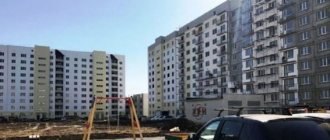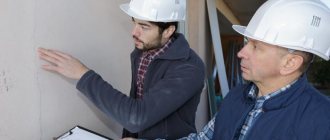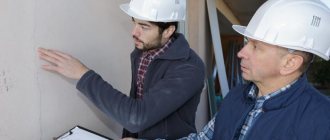The developer may bear expenses even after the house is put into operation
How can the developer justify the costs after receiving the commissioning certificate?
One of my colleagues asked this question on the Clerk forum.
The developer of a multi-apartment residential building has the right to attract funds from shareholders only after receiving permission to construct a real estate property (Clause 1, Article 3 of Federal Law No. 214-FZ of December 30, 2004).
The transfer of a shared construction project to a shareholder, which is the execution of the concluded agreement, is permitted only after the developer receives permission to put the facility into operation (Clause 1, Article 4 of Law No. 214-FZ).
And right away I would like to note that the permit to put the facility into operation (in the form approved by order of the Ministry of Construction of Russia dated February 19, 2015 No. 117/pr) is a document confirming that all work on the erection of the facility, that is, an apartment building , specified in the construction permit and design documentation, have been completed (clause 1 of article 55 of the Civil Code of the Russian Federation).
But the developer enters into contracts with shareholders not for the construction of the entire house, but for the construction for each of them of a separate object (apartment or non-residential premises) that is part of this house.
And the developed design documentation for the house and the construction permit obtained on its basis will most likely not take into account all the terms of the agreements for participation in shared construction. For example, the finishing of staircase landings, the apartments themselves, features of their internal layout, etc., etc., etc.
Consequently, the received permission to enter will also not take these conditions into account.
Thus, obtaining permission to open a multi-apartment residential building as a separate standing property does not in any way mean that the construction of all shared construction projects in this building, that is, apartments and non-residential premises in this building, has already been completed and the developer’s obligations for agreements for participation in shared construction have been completed.
The developer’s obligations for a specific DUDS are considered fulfilled on the date of transfer of the apartment (or non-residential premises) to the shareholder (Clause 1, Article 12 of Law No. 214-FZ), that is, the signing of the acceptance deed with the shareholder.
Officials finally agreed with this. They came to the conclusion that the developer of an apartment building should determine his profit not as a whole for the building on the date of issuing permission to enter it, but for each agreement for participation in shared construction on the date of signing the transfer and acceptance certificate with the shareholder (letter from the Ministry of Finance of Russia dated 07.08 .2018 No. 03-03-06/1/55395, dated 10/08/2019 No. 03-11-06/2/77017). In particular, in the first letter they refer to the Ruling of the Supreme Court of the Russian Federation dated 06/05/2017 No. 303-KG17-5474 in case No. A04-2505/2016.
In later disputes, the courts also began to make similar decisions (Resolution of the Eighth Arbitration Court of Appeal dated 06.06.2019 No. 08AP-3759/2019 in case No. A70-16544/2018, Resolution of the Fourteenth Arbitration Court of Appeal dated 22.11.2018 No. 14AP-8696/2018 in case No. A66-6508/2018).
The deadline for the transfer of shared construction objects must be the same for all shareholders of a built house (block section of an apartment building with a separate entrance with access to a common area) (Clause 1, Article 6 of Law No. 214-FZ).
But signing transfer and acceptance certificates with all shareholders of the house (in a separate block section) in one day is theoretically possible, but practically impossible. And is there a guarantee that the shareholder, as soon as he crosses the threshold of his new apartment, will immediately reach for the pen (that is, the pen), with the pen - to the paper (deed), for a minute - and the poems will flow freely, that is, he will sign the deed.
On the contrary, the shareholder will re-measure the entire apartment with a laser tape measure and try to prove that its total area is not 82.5 square meters. m., as indicated in the contract and deed, but only 81.7 sq. m. m. Money for 0.8 sq. m, the developer must return it and redo the deed. In addition, a construction specialist who comes with the shareholder (or a friend with such a reputation) will begin (whether justified or not, this is the second question) to cling to the slightest flaws and quite reasonably demand their elimination.
And if the first shareholder, perhaps, can be persuaded to sign the deed, promising to eliminate all the identified shortcomings - well, just half an hour later, the team has already been called, they receive the materials at the warehouse, and in the meantime you sign the deed.
But with the second, this option may not work, and before the developer (or rather, his subcontractor) does not eliminate all the identified deficiencies that the developer missed, but the vigilant shareholder discovered, the deed will not be signed.
Thus, even after a series of acceptance certificates have been signed, work on the house can (and more often than not, will) continue. The costs of carrying them out should absolutely be recognized as economically justified and used for the construction of this house (Clause 1, Article 18 of Law No. 214-FZ).
Costs incurred after the signing of one or more acceptance certificates may, for example, increase the costs of constructing a particular apartment if, for example, deficiencies inside it were eliminated, all still untransferred apartments on the floor (defects on the landing were eliminated), or in general in the entrance (defects were identified at the entrance to the entrance).
In addition, the developer bears the costs of maintaining all the apartments that have not yet been transferred through utility bills, which should also be included in his expenses.
But even if it is possible to conclude equity participation agreements for all the apartments in the building during its construction and the transfer of apartments to shareholders occurs without any problems, the developer may have expenses for this house for another 5 years.
The warranty period for deficiencies found in the house (except for technological and engineering equipment) must be at least 5 years (Clause 5, Article 7 of Law No. 214-FZ). For equipment it is 3 years (clause 5.1 of article 7 of Law No. 214-FZ).
If during this period the tenant (owner of the premises) identifies any “jambs” and proves that they were caused by the fault of the builders during the construction of the house, then the developer will be obliged to eliminate them.
These expenses, incurred in accordance with the law, will have to reduce his profit for the period in which he will correct the discovered deficiencies.
From all of the above, we can conclude that obtaining permission to put into operation an apartment building for a developer is also not the end of the process of its construction, but only the beginning of a long and difficult journey to transfer the constructed apartments. And there is still a very, very long way to go before summing up the results, rewarding the innocent, punishing the innocent (as well as the ceremonial banquet with the final fight).
VAT – 2022
The best speaker on tax topics, , will prepare you for filing your return on January 14 . There are 10 out of 40 places left for the online workshop . The flow is limited, as there will be live communication with the teacher live. Hurry up to get into the group. Sign up>>>
What is individual housing construction and capital construction?
Individual housing construction is individual residential construction, a type of permitted use of land on which capital construction projects can be built.
Such a house should have no more than 3 floors, and one family should live in it . The property must be provided with the communications necessary for life: heating, gas supply, electricity, water, sewerage. The infrastructure of the object must allow access to it: roads are needed.
Individual housing construction objects are located on the lands of populated areas . It will not be possible to build a house on agricultural land or in the country’s forest resources. Theoretically, it is certainly possible to build it, but it will be recognized as an unauthorized construction, subject to mandatory demolition.
A private residential building is recognized as a capital building . There is no precise definition of this concept in legislative norms.
In general, a capital construction project is understood as a building on a foundation that is firmly connected to the ground, deepened into it and made of durable building materials.
Drawing up a technical plan
Only a cadastral engineer who is a member of a self-regulatory organization can draw up a technical plan (Article 37 of Law No. 221-FZ of July 24, 2007). When registering a house, the electronic technical plan is placed in the Unified State Register of Real Estate, therefore, the cadastral engineer must provide exactly this option. At the request of the customer, the engineer can also make a paper version, as well as independently carry out registration actions in Rosreestr.
To draw up a technical plan, the engineer will need an extract from the USRN for the land plot, a notice of compliance with the planned construction (if issued), design documentation (if any), possibly other information provided for in clause 20 of the Requirements of the Ministry of Economic Development for the preparation of a technical plan. The finished technical plan must comply with the form established by law and consist of text and graphic parts. The first contains information entered into the Unified State Register of Real Estate about the site, its owner and the work performed by the engineer. The second contains a graphic image of the land plot and the house located on it, as well as a plan of the building itself.
Simplified diagram
The meaning of this registration is the simplicity of preparing the necessary approvals and permits, and there is no supervision of construction, that is, strict regulatory rules. You just need to start collecting all the documents, and there is no need to go through mandatory approvals with various interdepartmental organizations. The list of documents is general for both simplified and regular commissioning of a house, and you also need to contact the town planning department of the local administration.
The decision is made within a month if, according to the documents, the house is built and connected to communications without violating generally accepted rules.
But for this it is necessary to conduct a technical inspection of the site, that is, what type of land it belongs to, what communications run through the site.
This must be done by representatives of local authorities themselves, that is, they must come to the site and inspect everything. This document will be sufficient to issue an act of acceptance of work and commissioning of the house.
Price
All official services of a cadastral engineer or BTI are provided on a paid basis; in different regions, the cost of services can vary from 10 to 30 thousand rubles.
The cost of registering property rights is 2,200 rubles for individuals. All certificates and approvals should be provided free of charge, but this is a very controversial issue.
- Author: Anastasia
Rate this article:
- 5
- 4
- 3
- 2
- 1
(28 votes, average: 4.1 out of 5)
Share with your friends!
Notification of non-compliance
If the constructed facility does not comply with land use rules, urban planning standards, SNiPs or the parameters specified in the notice of the start of construction, then registration will be denied. The administration will notify the owner of the land plot about this by sending him a notice of non-compliance of the property with regulatory requirements.
The solution to the problem depends on the reason for the failure. Often violations are associated with a lack of approvals, if the site is located in a protected zone, or with the intersection of the developer’s site with forest fund lands. In these cases, to obtain permission, it is enough to attach the missing documents.
If the house was built in non-compliance with building codes (for example, they did not set aside 3 m from the border of the neighboring plot or exceeded the permissible height of the house), the object can be legitimized through the court. And here you cannot do without the help of an experienced lawyer who will competently draw up a claim for recognition of ownership of the property and protect the interests of the developer in court.








